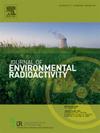Wet deposition of radionuclides: interception under sprinkler irrigation
IF 2.1
3区 环境科学与生态学
Q3 ENVIRONMENTAL SCIENCES
引用次数: 0
Abstract
The paper presents novel data on the interception of radionuclides in vegetables using sprinkler irrigation as a simulator of artificial rain. This information is essential for risk evaluations during both routine operations of nuclear facilities and potential accidental events. In countries with dry climates, where irrigation is an integral part of farming technologies, data on the interception of radionuclides by vegetable crops is crucial for effectively organizing irrigation using cooling water from nuclear reactors. The experiments were conducted in the North Caucasus, a region known for intensive irrigated agriculture, utilizing common vegetable crops such as tomatoes, cucumbers, carrots, table beets, and onions. The research employed a wide range of radionuclides: 59Fe, 60Co, 65Zn, 89Sr, 106Ru, 134Cs, and 144Ce. The study investigated the effects of element properties, plant development stages, and rainfall amounts on radionuclide interception in the crops. It was found that increasing rainfall from 10 to 30 mm resulted in a 1.5– to 3.2–fold increase in the concentration of 59Fe and a 1.2– to 3.3–fold increase in the concentration of 134Cs in the vegetative mass of plants. A further increase in rainfall, up to 70 mm, did not significantly alter the concentration of either radionuclide in the vegetative mass or the edible parts of the vegetable crops. New approximation was suggested for variations in interception factors with standing biomass of vegetable crops. Based on the strength of their fixation to plant foliage, the radionuclides can be ranked as follows: 65Zn ≈ 144Ce ≥ 60Co ≥ 106Ru > 134Cs.

放射性核素的湿沉降:喷灌下的拦截
本文介绍了利用喷灌模拟人工降雨对蔬菜中放射性核素进行拦截的新数据。这些信息对于核设施的日常运行和潜在事故事件的风险评估都是必不可少的。在气候干燥的国家,灌溉是农业技术的一个组成部分,关于蔬菜作物拦截放射性核素的数据对于有效组织利用核反应堆冷却水进行灌溉至关重要。实验是在北高加索进行的,这是一个以集约化灌溉农业而闻名的地区,利用了常见的蔬菜作物,如西红柿、黄瓜、胡萝卜、甜菜和洋葱。这项研究使用了多种放射性核素:59Fe、60Co、65Zn、89Sr、106Ru、134Cs和144Ce。研究了元素特性、植物发育阶段和降雨量对作物放射性核素拦截的影响。结果表明,降雨量从10 ~ 30 mm增加,植物营养物质中59Fe浓度增加1.5 ~ 3.2倍,134Cs浓度增加1.2 ~ 3.3倍。降雨量进一步增加,达到70毫米,并没有显著改变蔬菜作物营养团块或可食用部分中的放射性核素浓度。提出了蔬菜作物截留因子随立木生物量变化的新近似。根据其对植物叶片的固定强度,放射性核素的排列顺序为:65Zn≈144Ce≥60Co≥106Ru >;134 cs。
本文章由计算机程序翻译,如有差异,请以英文原文为准。
求助全文
约1分钟内获得全文
求助全文
来源期刊

Journal of environmental radioactivity
环境科学-环境科学
CiteScore
4.70
自引率
13.00%
发文量
209
审稿时长
73 days
期刊介绍:
The Journal of Environmental Radioactivity provides a coherent international forum for publication of original research or review papers on any aspect of the occurrence of radioactivity in natural systems.
Relevant subject areas range from applications of environmental radionuclides as mechanistic or timescale tracers of natural processes to assessments of the radioecological or radiological effects of ambient radioactivity. Papers deal with naturally occurring nuclides or with those created and released by man through nuclear weapons manufacture and testing, energy production, fuel-cycle technology, etc. Reports on radioactivity in the oceans, sediments, rivers, lakes, groundwaters, soils, atmosphere and all divisions of the biosphere are welcomed, but these should not simply be of a monitoring nature unless the data are particularly innovative.
 求助内容:
求助内容: 应助结果提醒方式:
应助结果提醒方式:


